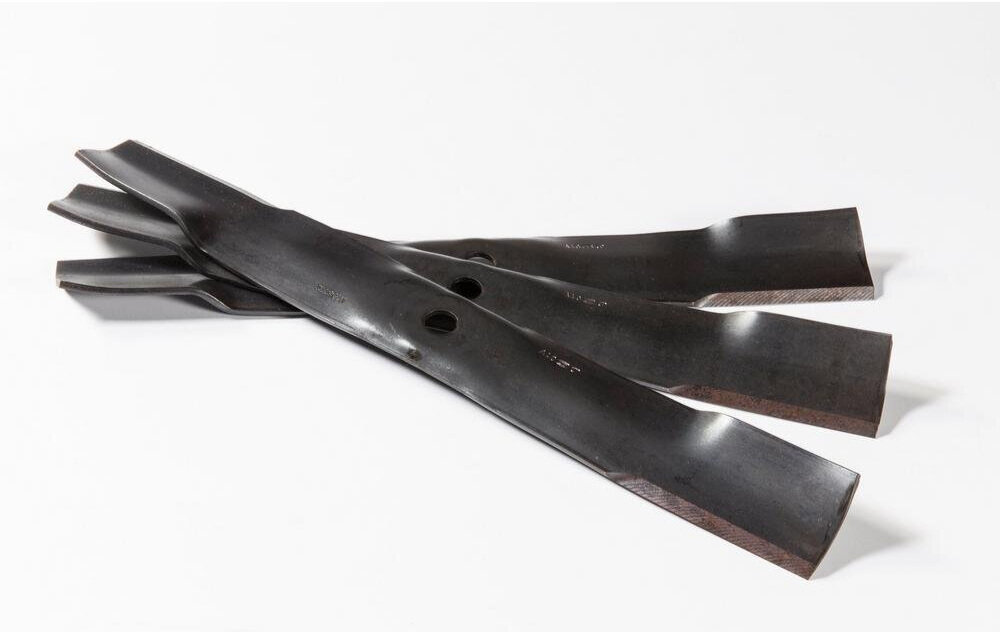Mower Blade Guide
Depending on the shape of your mower blade, we have developed different models to obtain the desired cutting edge. Below are some blade descriptions along with our recommended sharpener models. Please take the time to scroll down and review this information before making a purchase.
Feel free to check in with us for any recommendations before purchasing. Click here for our Contact page.
About the Angles and Edges
When you look at your mower blade from the end, if the underside of the cutting edge is not flat to a table (parallel to the ground or center section), that will alter the angle of your grind. This is a tilt or twist forward, similar to a propeller. If you have a blade like that, you will want a Model 5005. The 5005 gives you the ability to easily adjust the grinding angle to compensate for the altered cutting edge angle. The video below goes into more detail. After reviewing the information below, if you are still unsure about your blade geometry, please contact us and we will help you choose the right model for your mower blades.
Blades With Potential Issues
We have encountered some mower blade styles that have issues being mounted in our vise. If you have one of these, you should check in with us first.
Some eXmark 48” and smaller deck mowers have bi-level mulching blades where the cutting edge runs all the way into the center of the blade, beyond the center hole. This will cause mounting issues in our vise system that we do not yet have a solution for.
Some mower blades have raised edges on the sides in the center mounting area. Not all, but some Toro, Snapper, and Cub Cadet blades fall into this category. There are other brands that may have this geometry as well. This causes issues but can be overcome by backing the vise screws out to raise them up so the blade will fit under them.
Snapper Ninja mower blades are not able to be sharpened in our current units. We have not been able to create an adapter that will allow you to grind on the 4 blade edges.
John Deere makes a mower blade for some older series of tractors that is too wide to fit in our jigs. These blades have a circular center hub that is 4 inches wide. We do not have an adapter or mounting solution for this type of mower blade.
Dixie Chopper blades with the X—Blade system have raised centers that are stamped at an angle. This causes mounting issues in our vise system. We now have an additional adapter that can be used to properly mount the X-blades in our system.
Honda riding lawn tractor mulching blades have a shape that will cause issues in our jigs. We have not been able to test or accommodate these blades yet. We do have an adapter for the Honda walk behind Microcut Twin Blade Sets.
Standard Mower Blades
The standard blade, as we refer to it, doesn't have any altered angles along the cutting edge. It's straight and simple. If you are looking to grind a 30 degree edge on these blades, you only need the Model 5002. If you want more angle options and versatility, check out the Model 5005.
John Deere Blades
John Deere mower blades can look deceptively like standard straight blades. But many, if not most of them, have a significant tilt or twist forward in the cutting section, so it is not parallel with the center section. This will alter the angle of the grind, so a setting beyond 30 degrees is necessary to compensate for the tilt. Our Model 5005 is the only jig we provide that makes it easy to choose steeper angle settings. Many John Deere customer have told us they needed to adjust their 5005 all the way to the 45 degree setting.
** If the blade is used or worn, or has been previously sharpened, the angle may be beyond 45 degrees to the ground. If this is the case, it will take extra grinding to reset the angle. 45 degrees is the maximum angle adjustment in that direction. We have not found any new John Deere blades that needed an angle setting beyond 45 degrees. **
John Deere also makes a mower blade (pictured above) that is too wide to fit in our jigs. These blades have a circular center hub that is 4 inches wide. We do not have an adapter or mounting solution for this type of mower blade.
Gator Mulching Blades
Gator mulching blades look more complex because of the mulching fins. But the cutting edge is the only part that needs sharpened. We have found that, due to a slight tilt forward along the cutting edge, the 35 degree setting is best to keep the factory edge on most Gator blades. We have found that most Ferris blades also have a slight tilt forward and work best with the 35 degree setting as well. The Model 5005 gives you the ability to grind at that angle.
Commercial Bi-level Mulching Blades
Bi-level mulching blades are a little more tricky. The outside cutting edge is parallel to the mounting surface. But the inside mulching section edge is raised and stamped at a different angle. We created the Model 5000 specifically to handle these. With a simple flick of the wrist, you can switch between the 30 degree setting on the outside edge or the 15 degree setting for inside mulching edge. In many cases, the Model 5005 is the better choice due to angle variances. Please read the text below …
* If the underside of the outer cutting edge is not flat or parallel to the ground or the mounting section of your blade, it will alter your grinding angle. If that is the case, you will need a Model 5005 to compensate for the altered cutting edge angle.
Twisted High Lift Blades
We used to refer to these as high lift blades. But some mower blades are considered high lift without having the twisted end that makes these unique. That twist on the end alters the angle of the cutting edge. Since the cutting edge angles upward and isn't parallel with the mounting surface, there needs to be an adjustment to compensate for that angle. The Model 5005 gives you the angle adjustments needed to fine tune your grinding edge to your preference. We see this type of blade on a lot of John Deere mowers. But there are other brands that incorporate a twisted high lift blade as well.
Honda Mower Blades
Honda Quadracut and MicroCut Twin Blade sets have a unique design and shape. We have fabricated an adapter so these blades can be mounted in our jigs. To match the factory bevel, we recommend the Model 5005 in conjunction with the Honda Adapter.
*NOTE: As Honda is making a lot of different shaped blades, we have learned that the following Honda blades may be able to be sharpened without the need for the adapter.
Mower Models: HRN216, HRN216VKA, HRN216VKAA
Upper Blades: 72531-VR8-M00, VR8-M00 W154825
Lower Blades: 72511-VR8-M00, VR8-M00 W154945
Counter-Rotating Mower Blades
Some mowers use blades that rotate in the opposite direction. We have heard these referred to as left-hand, counterclockwise, and counter-rotating blades. These will have the cutting edge on the other side of the blade. To adjust for this, all of our current Generation 2 models have extended guide arms. This gives you the extra range of motion needed to reach the cutting edge of your counter-rotating blades at the the bottom of the jig. We have seen these types of blades on many Walker mowers. But they are not exclusive to that brand. The 35 degree setting worked well with the Walker blades we have tested. For that reason, if you are planning to sharpen Walker mower blades, we recommend the Model 5005.
Kubota Mower Blades
Multiple Kubota customers have told us they needed the 35 or 40 degree setting to match the factory bevel on their mower blades. For that reason, we recommend the Model 5005 Gen 2, because it is the only unit that can easily adjust beyond 30 degrees.

















